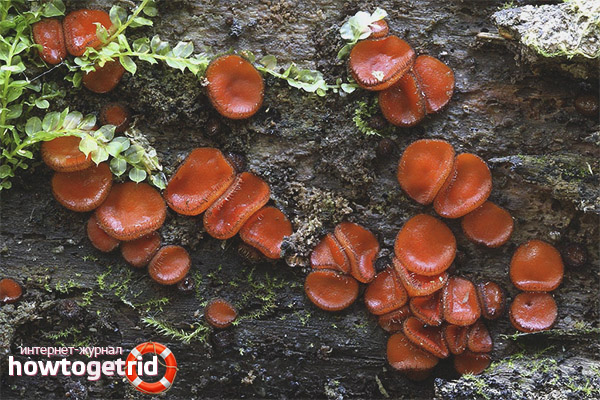The content of the article
Thyroid scutellinia is a marsupial fungus that belongs to the pyroneemic family (the genus of scutellinia). In addition, representatives of this species are ascomycetes, that is, their structure implies the presence of a special spore bag, which, in fact, is the main organ of sporulation. The Latin name for this fungus sounds like Scutellinia scutellata. Also, this inedible marsupial species of mushrooms is often called saucer-shaped scutellinia.
I would like to note that the fungi of the pyroneme family are the most diverse both in their ecology and in morphology. Their representatives, in particular, and thyroid scutellinia, form characteristic cup-shaped apothecia of various sizes. In addition, the species of this family most often differ from others in their rather bright and eye-catching color, as a rule, these are juicy orange and red colors, which is caused by the presence of carotenoid pigments in the structure of fungi.
View description
The species of mushrooms presented to attention has rather modest sizes and most often the fruit body of the saucer-shaped scutellinia does not exceed the size of an ordinary coin. At the beginning of its development, the shape of young specimens resembles a ball; with the growth of the fungus, it becomes disc-shaped with a small indentation. The inner part of the scutellinia is bright red, the surface has a paler color - most often yellow-brown.
The edge of the fruiting body of this type of mushroom is densely dotted with small hairs, which resembles bristles, the color of the hairs is dark. At the edges of the fruiting body is located more densely, forming a kind of fringe.
The pulp of the fungus, as in most pecones of the pyronemon family, is distinguished by its fragility, has a characteristic red-bright color. The spores of the fungus are elliptical, almost colorless, densely dotted with small growths (warts).
Directly, the pulp of the mushroom itself is quite thin without any pronounced smell and taste.
Features of fruiting species
Temperature indicators for the best growth of these mushrooms vary in the range from 22 to 28 degrees. In this case, a prerequisite is increased soil and air humidity. For this reason, the peak fruiting saucer-shaped scutellinia coincides with the beginning of the warm season.
As a rule, this type of mushroom grows in heaps - in small groups, so in order to find them, it does not take much effort. Also attracting the attention of mushroom pickers and their characteristic appearance, namely, the bright color of the fruiting body. These mushrooms are cut with a sharp knife - in order not to damage both the fruit body of the scutellinia itself and the mycelium.
Mushroom edibility

Saucerous scutellinia belongs to the category of inedible species of mushrooms, due to its small size.
Related species
There are several species of the family of peppers, outwardly similar to a mushroom such as scutellinia, which, like this species, have a characteristic bristled fringe located along the edge of the fruit body.
Dark chestnut pepper - this species belongs to conditionally edible mushrooms.The shape of the fruiting body is spherical, with growing older it becomes more like a disk or a small saucer, the maximum diameter does not exceed 50-60 mm.
The inner surface of this fungus has a brown-olive color with a pleasant matte shade, the color of the outer part is chestnut with characteristic whitish growths - grains. The pulp of the mushroom does not have a specific odor, rather thin and brittle.
The fruiting season of this species is from May to early autumn. Often grow in the vicinity of such mushrooms as morel cap. Most often, their main habitat is moist soil in mixed and coniferous forests. Fruiting is carried out annually in groups. This similar type of mushroom is the most common among all types of peppers, culinary processing of dark chestnut peppers implies their boiling and drying.
Another similar species is conditionally edible mushroom - bubbly pepper, bearing fruit from May to mid-autumn.










Submit